Physical and Mechanical Characterization of Titica Vine (Heteropsis flexuosa) Incorporated Epoxy Matrix Composites
Abstract
:1. Introduction
2. Materials and Methods
2.1. Materials
2.2. Composites Processing
2.3. Thermogravimetric Analysis (TGA)
2.4. Differential Scanning Calorimetry (DSC)
2.5. Water Absorption
2.6. Charpy and Izod Impact Tests
2.7. Statistical Validation
2.8. Scanning Electron Microscopy (SEM)
3. Results and Discussion
3.1. Thermogravimetric Analysis (TGA)
3.2. Differential Scanning Calorimetry (DSC)
3.3. Water Absorption
3.4. Statistical Validation of the Charpy and Izod Impact Tests
3.5. Scanning Electron Microscopy Analysis
3.6. Recommendation for Future Research
4. Conclusions
Supplementary Materials
Author Contributions
Funding
Institutional Review Board Statement
Informed Consent Statement
Data Availability Statement
Acknowledgments
Conflicts of Interest
References
- Mohammed, L.; Ansari, M.N.M.; Pua, G.; Jawaid, M.; Islam, S. A review on natural fiber reinforced polymer composite and its applications. Int. J. Polym. Sci. 2015, 2015, 1–15. [Google Scholar] [CrossRef] [Green Version]
- May-Pat, A.; Valadez-González, A.; Herrera-Franco, P.J. Effect of fiber surface treatments on the essential work of fracture of HDPE-continuous henequen fiber-reinforced composites. Polym. Test. 2013, 32, 1114–1122. [Google Scholar] [CrossRef]
- Luz, F.S.; Garcia Filho, F.C.; Del-Rio, M.T.C.; Nascimento, L.F.C.; Pinehro, W.A.; Monteiro, S.N. Graphene-incorporated natural fiber polymer composites: A first overview. Polymers 2020, 12, 1601. [Google Scholar] [CrossRef] [PubMed]
- Zhang, Z.; Cai, S.; Li, Y.; Wang, Z.; Long, Y.; Yu, T.; Shen, Y. High performances of plant fiber reinforced composites—A new insight from hierarchical microstructures. Compos. Sci. Technol. 2020, 194, 108151. [Google Scholar] [CrossRef]
- Vigneshwaran, S.; Sundarakannan, R.; John, K.; Johnson, R.D.J.; Prasath, K.A.; Ajith, S.; Arumugaprabu, V.; Uthayakumar, M. Recent advancement in the natural fiber polymer composites: A comprehensive review. J. Clean. Prod. 2020, 277, 124109. [Google Scholar] [CrossRef]
- Karimah, A.; Ridho, M.R.; Munawar, S.S.; Adi, D.S.; Damayanti, R.; Subiyanto, B.; Fatriasari, W.; Fudholi, A. A review on natural fibers for development of eco-friendly bio-composite: Characteristics, and utilizations. J. Mater. Res. Technol. 2021, 13, 2442–2458. [Google Scholar] [CrossRef]
- Potluri, R.; Krishna, N.C. Potential and applications of green composites in industrial space. Mater. Today Proc. 2020, 22, 2041–2048. [Google Scholar] [CrossRef]
- Kumar, R.; Haq, M.I.U.; Raina, A.; Anand, A. Industrial applications of natural fibre-reinforced polymer composites—Challenges and opportunities. Int. J. Sustain. Eng. 2018, 12, 212–220. [Google Scholar] [CrossRef]
- Dunne, R.; Desai, D.; Sadiku, R.; Jayaramudu, J. A review of natural fibres, their sustainability and automotive applications. J. Reinf. Plast. Compos. 2016, 35, 1041–1050. [Google Scholar] [CrossRef]
- Reddy, B.M.; Reddy, Y.V.M.; Reddy, B.C.M.; Reddy, R.M. Mechanical, morphological, and thermogravimetric analysis of alkali-treated Cordia-Dichotoma natural fiber composites. J. Nat. Fibers 2020, 17, 759–768. [Google Scholar] [CrossRef]
- Li, M.; Pu, Y.; Thomas, V.M.; Yoo, C.G.; Ozcan, S.; Deng, Y.; Nelson, K.; Ragauskas, A.J. Recent advancements of plant-based natural fiber–reinforced composites and their applications. Compos. Part B Eng. 2020, 200, 108254. [Google Scholar] [CrossRef]
- Dixit, S.; Goel, R.; Dubey, A.; Shivhare, P.R.; Bhalavi, T. Natural fibre reinforced polymer composite materials—A review. Polym. Renew. Resour. 2017, 8, 71–78. [Google Scholar] [CrossRef]
- Kalia, S.; Kaith, B.S.; Kaurs, I. Cellulose Fibers: Bio and Nano Polymer Composites: Green Chemistry and Technology; Springer Science & Business Media: New York, NY, USA, 2011. [Google Scholar]
- Poletto, M.; Júnior, H.L.O.; Zattera, A.J. Thermal decomposition of natural fibers: Kinetics and degradation mechanisms. In Reactions and Mechanisms in Thermal Analysis of Advanced Materials; John Wiley & Sons, Inc.: Hoboken, NJ, USA, 2015. [Google Scholar]
- Sanjay, M.R.; Madhu, P.; Jawaid, M.; Senthamaraikannan, P.; Senthil, S.; Pradeep, S. Characterization and properties of natural fiber polymer composites: A comprehensive review. J. Clean. Prod. 2018, 172, 566–581. [Google Scholar] [CrossRef]
- Pickering, K.L.; Efendy, M.G.A.; Le, T.M. A review of recent developments in natural fibre composites and their mechanical performance. Compos. Part A Appl. Sci. Manuf. 2016, 83, 98–112. [Google Scholar] [CrossRef] [Green Version]
- Kabir, M.M.; Wang, H.; Lau, K.T.; Cardona, F. Chemical treatments on plant-based natural fibre reinforced polymer composites: An overview. Compos. Part B Eng. 2012, 43, 2883–2892. [Google Scholar] [CrossRef]
- Al-Maharma, A.Y.; Al-Huniti, N. Critical review of the parameters affecting the effectiveness of moisture absorption treatments used for natural composites. J. Compos. Sci. 2019, 3, 27. [Google Scholar] [CrossRef] [Green Version]
- Faruk, O.; Bledzki, A.K.; Fink, H.-P.; Sain, M. Biocomposites reinforced with natural fibers: 2000–2010. Prog. Polym. Sci. 2012, 37, 1552–1596. [Google Scholar] [CrossRef]
- Gholampour, A.; Ozbakkaloglu, T. A review of natural fiber composites: Properties, modification and processing techniques, characterization, applications. J. Mater. Sci. 2019, 55, 829–892. [Google Scholar] [CrossRef]
- Krishnudu, D.M.; Sreeramulu, D.; Reddy, P.V. Alkali treatment effect: Mechanical, thermal, morphological, and spectroscopy studies on abutilon indicum fiber-reinforced composites. J. Nat. Fibers 2020, 17, 1775–1784. [Google Scholar] [CrossRef]
- Serra-Parareda, F.; Espinach, F.X.; Pelach, M.À.; Méndez, J.A.; Vilaseca, F.; Tarrés, Q. Effect of NaOH treatment on the flexural modulus of hemp core reinforced composites and on the intrinsic flexural moduli of the fibers. Polymers 2020, 12, 1428. [Google Scholar] [CrossRef]
- de Araujo Alves Lima, R.; Cavalcanti, D.K.; de Souza e Silva Neto, J.; da Costa, H.M.; Banea, M.D. Effect of surface treatments on interfacial properties of natural intralaminar hybrid composites. Polym. Compos. 2020, 41, 314–325. [Google Scholar] [CrossRef]
- Bartos, A.; Utomo, B.P.; Kanyar, B.; Anggono, J.; Soetaredjo, F.E.; Móczó, J.; Pukánszky, B. Reinforcement of polypropylene with alkali-treated sugarcane bagasse fibers: Mechanism and consequences. Compos. Sci. Technol. 2020, 200, 108428. [Google Scholar] [CrossRef]
- Raia, R.Z.; Iwakiri, S.; Trianoski, R.; de Andrade, A.S.; Kowalski, E.L. Effects of alkali treatment on modification of the Pinus fibers. Matéria 2021, 26, 1–9. [Google Scholar] [CrossRef]
- Machaka, M.; Basha, H.; Abou Chakra, H.; Elkordi, A. The effect of using fan palm natural fibers on the mechanical properties and durability of concrete. Int. J. Mater. Sci. Eng. 2014, 10, 1857–7881. [Google Scholar] [CrossRef]
- dos Santos, J.C.; Siqueira, R.L.; Vieira, L.M.G.; Freire, R.T.S.; Mano, V.; Panzera, T.H. Effects of sodium carbonate on the performance of epoxy and polyester coir-reinforced composites. Polym. Test. 2018, 67, 533–544. [Google Scholar] [CrossRef]
- Megiatto, J.D.; Cerrutti, B.M.; Frollini, E. Sodium lignosulfonate as a renewable stabilizing agent for aqueous alumina suspensions. Int. J. Biol. Macromol. 2016, 82, 927–932. [Google Scholar] [CrossRef]
- Ye, D.Z.; Jiang, L.; Hu, X.-Q.; Zhang, M.-H.; Zhang, X. Lignosulfonate as reinforcement in polyvinyl alcohol film: Mechanical properties and interaction analysis. Int. J. Biol. Macromol. 2016, 83, 209–215. [Google Scholar] [CrossRef] [PubMed]
- Klauberg, C.; Vidal, E.; Silva, C.A.; Bentes, M.D.M.; Hudak, A.T. Sampling methods for titica vine (Heteropsis spp.) inventory in a tropical forest. Ann. For. Sci. 2016, 73, 757–764. [Google Scholar] [CrossRef] [Green Version]
- Costa, U.O.; Nascimento, L.F.C.; Garcia, J.M.; Bezerra, W.B.A.; da Costa, G.F.F.; da Luz, F.S.; Pinheiro, W.A.; Monteiro, S.N. Mechanical properties of composites with graphene oxide functionalization of either epoxy matrix or curaua fiber reinforcement. J. Mater. Res. Technol. 2020, 9, 13390–13401. [Google Scholar] [CrossRef]
- Demosthenes, L.C.C.; Nascimento, L.F.C.; Monteiro, S.N.; Costa, U.O.; Garcia Filho, F.C.; Luz, F.S.; Oliveira, M.S.; Ramos, F.J.H.T.V.; Pereira, A.C.; Braga, F.O. Thermal and structural characterization of buriti fibers and their relevance in fabric reinforced composites. J. Mater. Res. Technol. 2020, 9, 115–123. [Google Scholar] [CrossRef]
- Cunha, J.S.C.; Neto, H.E.O.; Giacon, V.M.; Manzato, L.; Silva, C.G. Study on mechanical and thermal properties of Amazon fibers on the polymeric biocomposites: Malva and tucum. Fibers Polym. 2021, 1–9. [Google Scholar] [CrossRef]
- Reis, R.H.M.; Nunes, L.F.; da Luz, F.S.; Candido, V.S.; da Silva, A.C.R.; Monteiro, S.N. Ballistic performance of guaruman fiber composites in multilayered armor system and as single target. Polymers 2021, 13, 1203. [Google Scholar] [CrossRef]
- Oliveira, F.; Silva, C.G.; Ramos, L.A.; Frollini, E. Phenolic and lignosulfonate-based matrices reinforced with untreated and lignosulfonate-treated sisal fibers. Ind. Crop. Prod. 2017, 96, 30–41. [Google Scholar] [CrossRef]
- Kerche, E.F.; da Silva, V.D.; Fonseca, E.; Salles, N.A.; Schrekker, H.S.; Amico, S.C. Epoxy-based composites reinforced with imidazolium ionic liquid-treated aramid pulp. Polymers 2021, 226, 123787. [Google Scholar] [CrossRef]
- Jojibabu, P.; Zhang, Y.X.; Prusty, B.G. A review of research advances in epoxy-based nanocomposites as adhesive materials. Int. J. Adhes. Adhes. 2020, 96, 102454. [Google Scholar] [CrossRef]
- Nascimento, L.F.C.; Louro, L.H.L.; Monteiro, S.N.; Lima, É.P.; da Luz, F.S. Mallow fiber-reinforced epoxy composites in multilayered armor for personal ballistic protection. JOM 2017, 69, 2052–2056. [Google Scholar] [CrossRef]
- Reis, R.H.; Filho, F.C.G.; Nunes, L.F.; Candido, V.S.; Silva, A.C.; Monteiro, S.N. Impact resistance of epoxy composites reinforced with Amazon guaruman fiber: A Brief Report. Polymers 2021, 13, 2264. [Google Scholar] [CrossRef]
- Costa, U.O.; Nascimento, L.F.C.; Bezerra, W.B.A.; Aguiar, V.O.; Pereira, A.C.; Monteiro, S.N.; Pinheiro, W.A. Dynamic mechanical behavior of graphene oxide functionalized curaua fiber-reinforced epoxy composites: A brief report. Polymers 2021, 13, 1897. [Google Scholar] [CrossRef]
- Oliveira, M.S.; Luz, F.S.D.; Souza, A.T.; Demosthenes, L.C.D.C.; Pereira, A.C.; Braga, F.D.O.; Figueiredo, A.B.-H.S.; Monteiro, S.N. Tucum fiber from Amazon Astrocaryum vulgare palm tree: Novel reinforcement for polymer composites. Polymers 2020, 12, 2259. [Google Scholar] [CrossRef] [PubMed]
- Da Luz, F.S.; Paciornik, S.; Monteiro, S.N.; Da Silva, L.C.; Tommasini, F.J.; Cândido, V.S. Porosity assessment for different diameters of coir lignocellulosic fibers. JOM 2017, 69, 2045–2051. [Google Scholar] [CrossRef]
- Truong, M.; Zhong, W.; Boyko, S.; Alcock, M. A comparative study on natural fibre density measurement. J. Text. Inst. 2009, 100, 525–529. [Google Scholar] [CrossRef]
- Ribeiro, M.P.; Neuba, L.M.; Silveira, P.H.P.M.; Luz, F.S.; Figueiredo, A.B.H.S.; Monteiro, S.N.; Moreira, M.O. Mechanical, thermal and ballistic performance of epoxy composites reinforced with Cannabis sativa hemp fabric. J. Mater. Res. Technol. 2021, 12, 221–233. [Google Scholar] [CrossRef]
- American Society for Testing and Materials. E 1131: Standard Test Method for Compositional Analysis by Thermogravimetry; American Society for Testing and Materials: West Conshohocken, PA, USA, 2003. [Google Scholar]
- American Society for Testing and Materials. D570-98: Standard Test Method for Water Absorption of Plastics; American Society for Testing and Materials: West Conshohocken, PA, USA, 2018. [Google Scholar]
- Espert, A.; Vilaplana, F.; Karlsson, S. Comparison of water absorption in natural cellulosic fibres from wood and one-year crops in polypropylene composites and its influence on their mechanical properties. Compos. Part A Appl. Sci. Manuf. 2004, 35, 1267–1276. [Google Scholar] [CrossRef]
- Megiatto, J.D., Jr.; Oliveira, F.B.; Rosa, D.S.; Gardrat, C.; Castellan, A.; Frollini, E. Renewable resources as reinforcement of polymeric matrices: Composites Based on Phenolic Thermosets and Chemically Modified Sisal Fibers. Macromol. Biosci. 2007, 7, 1121–1131. [Google Scholar] [CrossRef]
- Osman, E.A.; Vakhguelt, A.; Sbarski, I.; Mutasher, S.A. Kenaf/recycled jute natural fibers unsaturated polyester composites: Water absorption/dimensional stability and mechanical properties. Int. J. Comput. Mater. Sci. Eng. 2012, 1, 1250010. [Google Scholar] [CrossRef]
- American Society for Testing and Materials. D6110-18: Standard Test Method for Determining the Charpy Impact Resistance of Notched Specimens of Plastics; American Society for Testing and Materials: West Conshohocken, PA, USA, 2018. [Google Scholar]
- American Society for Testing and Materials. D256-10: Standard Test Methods for Determining the Izod Pendulum Impact Resistance of Plastics; American Society for Testing and Materials: West Conshohocken, PA, USA, 2000. [Google Scholar]
- Junio, R.F.P.; Nascimento, L.F.C.; Neuba, L.M.; Souza, A.T.; Moura, J.V.B.; Filho, F.C.G.; Monteiro, S.N. Copernicia Prunifera leaf fiber: A promising new reinforcement for epoxy composites. Polymers 2020, 12, 2090. [Google Scholar] [CrossRef] [PubMed]
- Silva, T.T.D.; Silveira, P.H.P.M.D.; Ribeiro, M.P.; Lemos, M.F.; Silva, A.P.; Monteiro, S.N.; Nascimento, L.F.C. Thermal and chemical characterization of kenaf fiber (Hibiscus cannabinus) reinforced epoxy matrix composites. Polymers 2021, 13, 2016. [Google Scholar] [CrossRef] [PubMed]
- Jin, F.-L.; Park, S.-J. Thermal properties of epoxy resin/filler hybrid composites. Polym. Degrad. Stab. 2012, 97, 2148–2153. [Google Scholar] [CrossRef]
- Monteiro, S.N.; Calado, V.; Margem, F.M.; Rodriguez, R.J. Thermogravimetric stability behavior of less common lignocellulosic fibers—A review. J. Mater. Res. Technol. 2012, 1, 189–199. [Google Scholar] [CrossRef] [Green Version]
- Yang, H.; Yan, R.; Chen, H.; Lee, D.H.; Zheng, C. Characteristics of hemicellulose, cellulose and lignin pyrolysis. Fuel 2007, 86, 1781–1788. [Google Scholar] [CrossRef]
- Xia, L.; Zhang, C.; Wang, Y.; Xu, W. Morphologies and properties of Juncus effusus fiber after alkali treatment. Celluloes 2020, 27, 1909–1920. [Google Scholar] [CrossRef]
- Sgriccia, N.; Hawley, M. Thermal, morphological, and electrical characterization of microwave processed natural fiber composites. Compos. Sci. Technol. 2007, 67, 1986–1991. [Google Scholar] [CrossRef]
- Fiore, V.; Scalici, T.; Nicoletti, F.; Vitale, G.; Prestipino, M.; Valenza, A. A new eco-friendly chemical treatment of natural fibres: Effect of sodium bicarbonate on properties of sisal fibre and its epoxy composites. Compos. Part B Eng. 2016, 85, 150–160. [Google Scholar] [CrossRef]
- Liu, Y.; Hu, H. X-ray diffraction study of bamboo fibers treated with NaOH. Fibers Polym. 2008, 9, 735–739. [Google Scholar] [CrossRef]
- El Oudiani, A.; Chaabouni, Y.; Msahli, S.; Sakli, F. Crystal transition from cellulose I to cellulose II in NaOH treated Agave americana L. fibre. Carbohydr. Polym. 2011, 86, 1221–1229. [Google Scholar] [CrossRef]
- Silva, G.G.; De Souza, D.A.; Machado, J.C.; Hourston, D.J. Mechanical and thermal characterization of native brazilian coir fiber. J. Appl. Polym. Sci. 2000, 76, 1197–1206. [Google Scholar] [CrossRef]
- Pinheiro, I.F.; Morales, A.R.; Mei, L.H.I. Polymeric biocomposites of poly (butylene adipate-co-terephthalate) reinforced with natural Munguba fibers. Cellulose 2014, 21, 4381–4391. [Google Scholar] [CrossRef]
- Barreto, A.C.H.; Rosa, D.S.; Fechine, P.B.A.; Mazzetto, S.E. Properties of sisal fibers treated by alkali solution and their application into cardanol-based biocomposites. Compos. Part A Appl. Sci. Manuf. 2011, 42, 492–500. [Google Scholar] [CrossRef]
- Neuba, L.M.; Junio, R.F.P.; Ribeiro, M.P.; Souza, A.T.; Lima, E.S.; Filho, F.C.G.; Figueiredo, A.B.H.S.; Braga, F.O.; Azevedo, A.R.G.; Monteiro, S.N. Promising mechanical, thermal, and ballistic properties of novel epoxy composites reinforced with Cyperus malaccensis sedge fiber. Polymers 2020, 12, 1776. [Google Scholar] [CrossRef]
- Souza, A.T.; Junio, R.F.P.; Neuba, L.M.; Candido, V.S.; Silva, A.C.R.; Azevedo, A.R.G.; Monteiro, S.N.; Nascimento, L.F.C. Caranan fiber from Mauritiella armata palm tree as novel reinforcement for epoxy composites. Polymers 2020, 12, 2037. [Google Scholar] [CrossRef]
- Jesuarockiam, N.; Jawaid, M.; Zainudin, E.S.; Sultan, M.T.H.S.; Yahaya, R. Enhanced thermal and dynamic mechanical properties of synthetic/natural hybrid composites with graphene nanoplateletes. Polymers 2019, 11, 1085. [Google Scholar] [CrossRef] [PubMed] [Green Version]
- Naveen, J.; Jawaid, M.; Zainudin, E.S.; Sultan, M.T.; Yahaya, R.; Majid, M.A. Thermal degradation and viscoelastic properties of Kevlar/Cocos nucifera sheath reinforced epoxy hybrid composites. Compos. Struct. 2019, 219, 194–202. [Google Scholar] [CrossRef]
- Revanth, J.S.; Madhav, V.S.; Sai, Y.K.; Krishna, D.V.; Srividya, K.; Sumanth, C.H.M. TGA and DSC analysis of vinyl ester reinforced by Vetiveria zizanioides, jute and glass fiber. Mater. Today Proc. 2020, 26, 460–465. [Google Scholar] [CrossRef]
- Junior, V.D.L.; Leão, R.M.; Steier, V.F.; Da Luz, S.M. Influence of cure agent, treatment and fibre content on the thermal behaviour of a curaua/epoxy prepreg. Plast. Rubber Compos. 2020, 49, 214–221. [Google Scholar] [CrossRef]
- Sen, A.K.; Kumar, S. Coir-fiber-based fire retardant nano filler for epoxy composites. J. Therm. Anal. Calorim. 2010, 101, 265–271. [Google Scholar] [CrossRef]
- Siregar, J.P.; Salit, M.S.; Rahman, M.Z.A.; Dahlan, K.Z.H.M. Thermogravimetric analysis (TGA) and differential scanning calometric (DSC) analysis of pineapple leaf fibre (PALF) reinforced high impact polystyrene (HIPS) composites. J. Sci. Technol. 2011, 19, 161–170. [Google Scholar]
- Ramachandran, M.; Bansal, S.; Raichurkar, P. Scrutiny of jute fiber poly-lactic acid (PLA) resin reinforced polymeric compo-site. J. Text. Assoc. 2016, 76, 372–375. [Google Scholar]
- Sider, I.; Nassar, M. Chemical treatment of bio-derived industrial waste filled recycled low-density polyethylene: A comparative evaluation. Polymers 2021, 13, 2682. [Google Scholar] [CrossRef]
- Chandekar, H.; Chaudhari, V.; Waigaonkar, S.; Mascarenhas, A. Effect of chemical treatment on mechanical properties and water diffusion characteristics of jute-polypropylene composites. Polym. Compos. 2019, 41, 1447–1461. [Google Scholar] [CrossRef]
- Filho, F.C.G.; Luz, F.S.; Nascimento, L.F.C.; Satyanarayana, K.G.; Drelich, J.W.; Monteiro, S.N. Mechanical properties of Boehmeria nivea natural fabric reinforced epoxy matrix composite prepared by vacuum-assisted resin infusion molding. Polymers 2020, 12, 1311. [Google Scholar] [CrossRef] [PubMed]
- Pupure, L.; Varna, J.; Joffe, R.; Berthold, F.; Miettinen, A. Mechanical properties of natural fiber composites produced using dynamic sheet former. Wood Mater. Sci. Eng. 2018, 15, 76–86. [Google Scholar] [CrossRef]
- Revol, B.P.; Vauthier, M.; Thomassey, M.; Bouquey, M.; Ruch, F.; Nardin, M. Design of experience to evaluate the Interfacial compatibility on high tenacity viscose fibers reinforced Polyamide-6 composites. Compos. Sci. Technol. 2021, 203, 108615. [Google Scholar] [CrossRef]
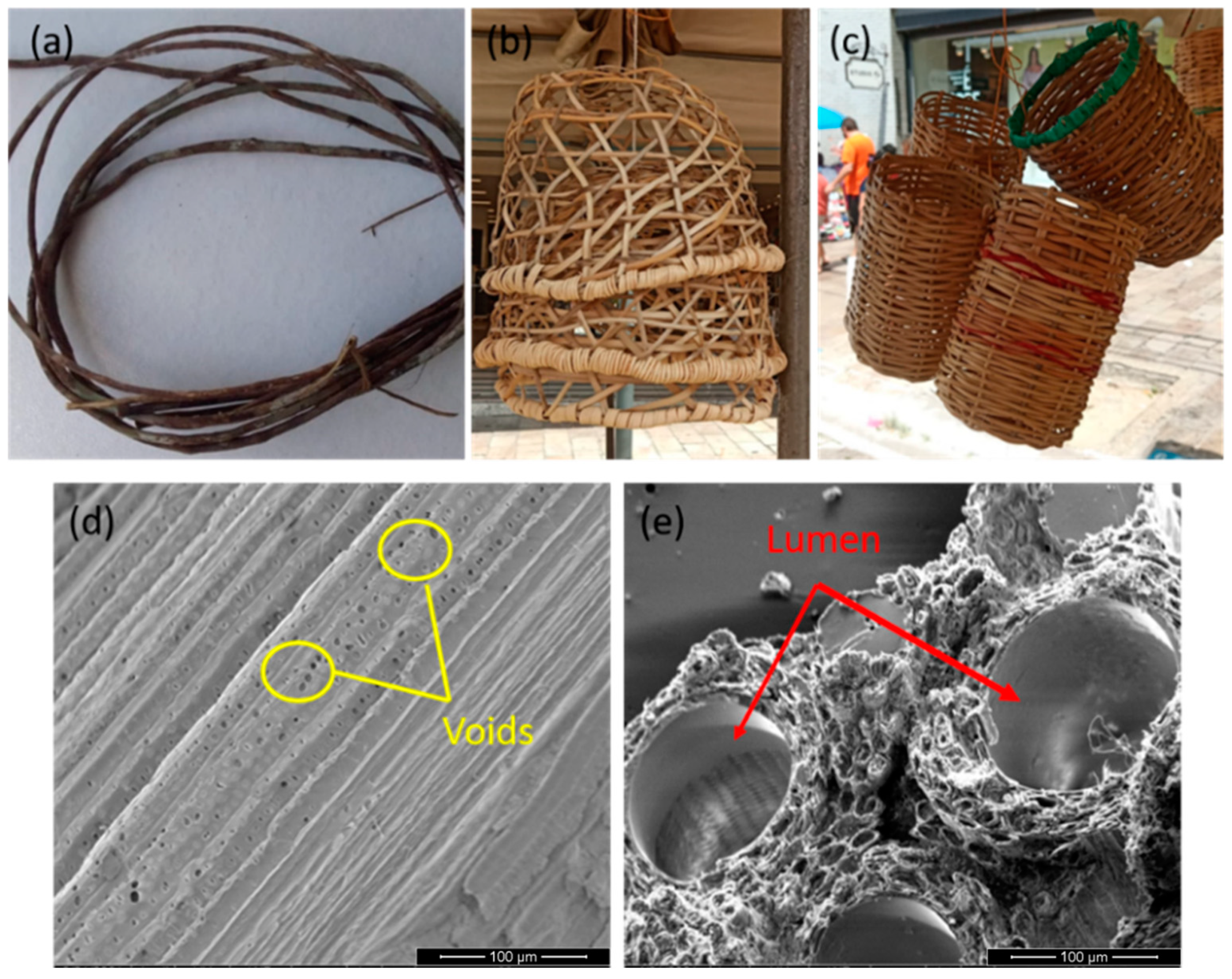

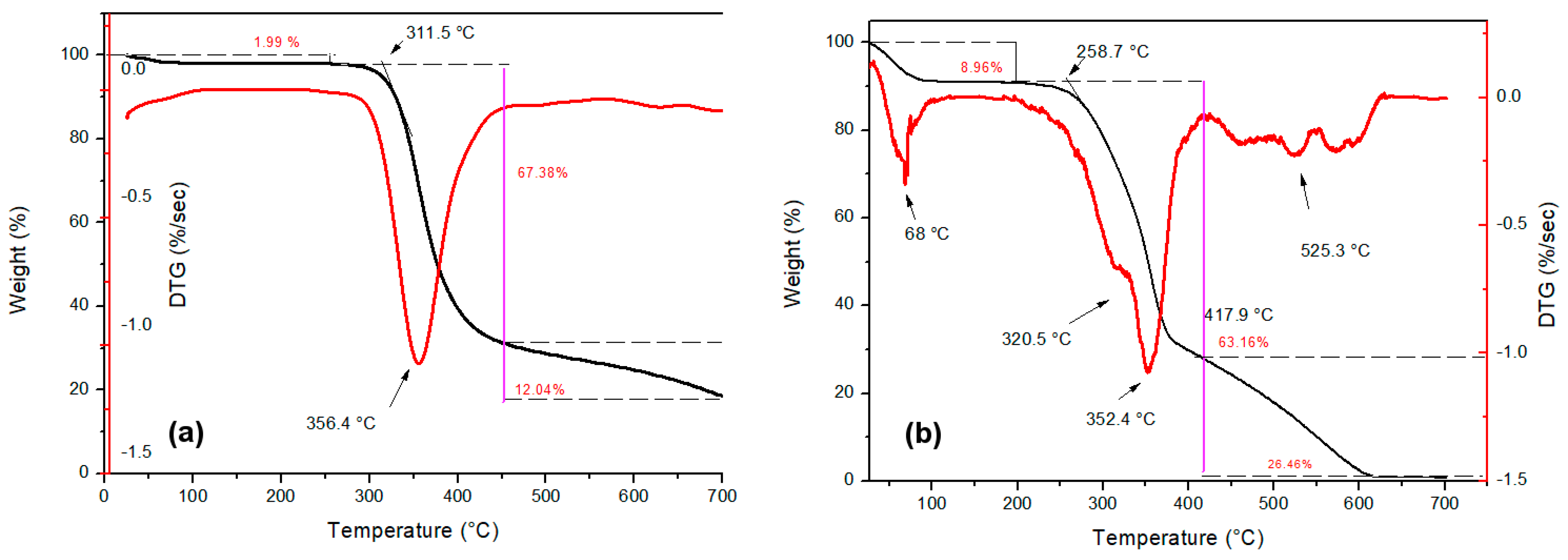


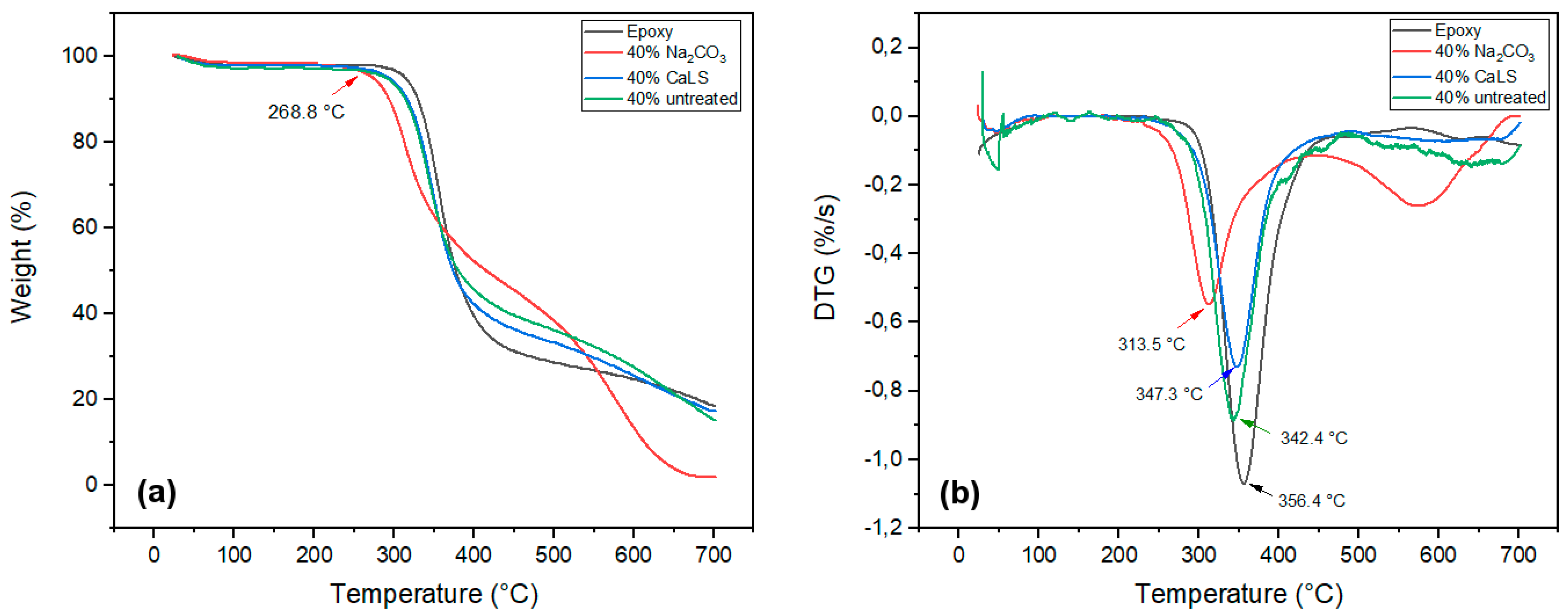
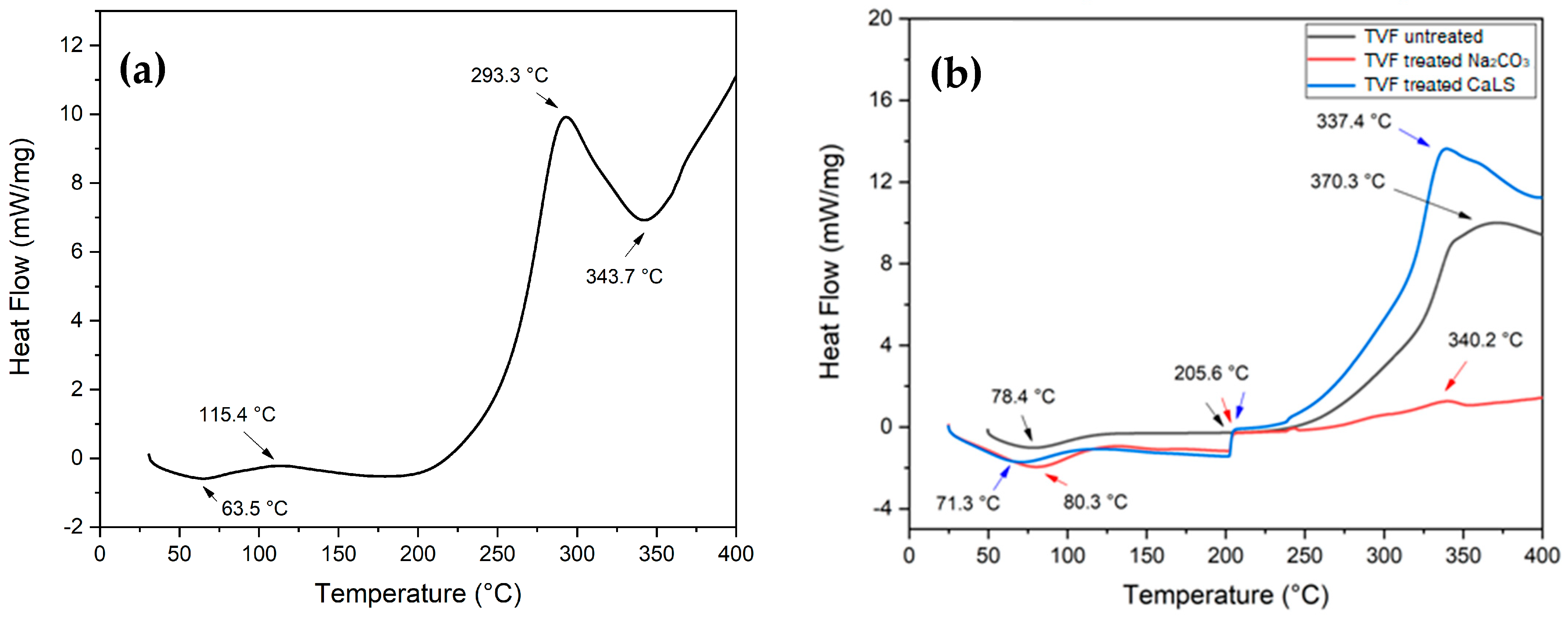
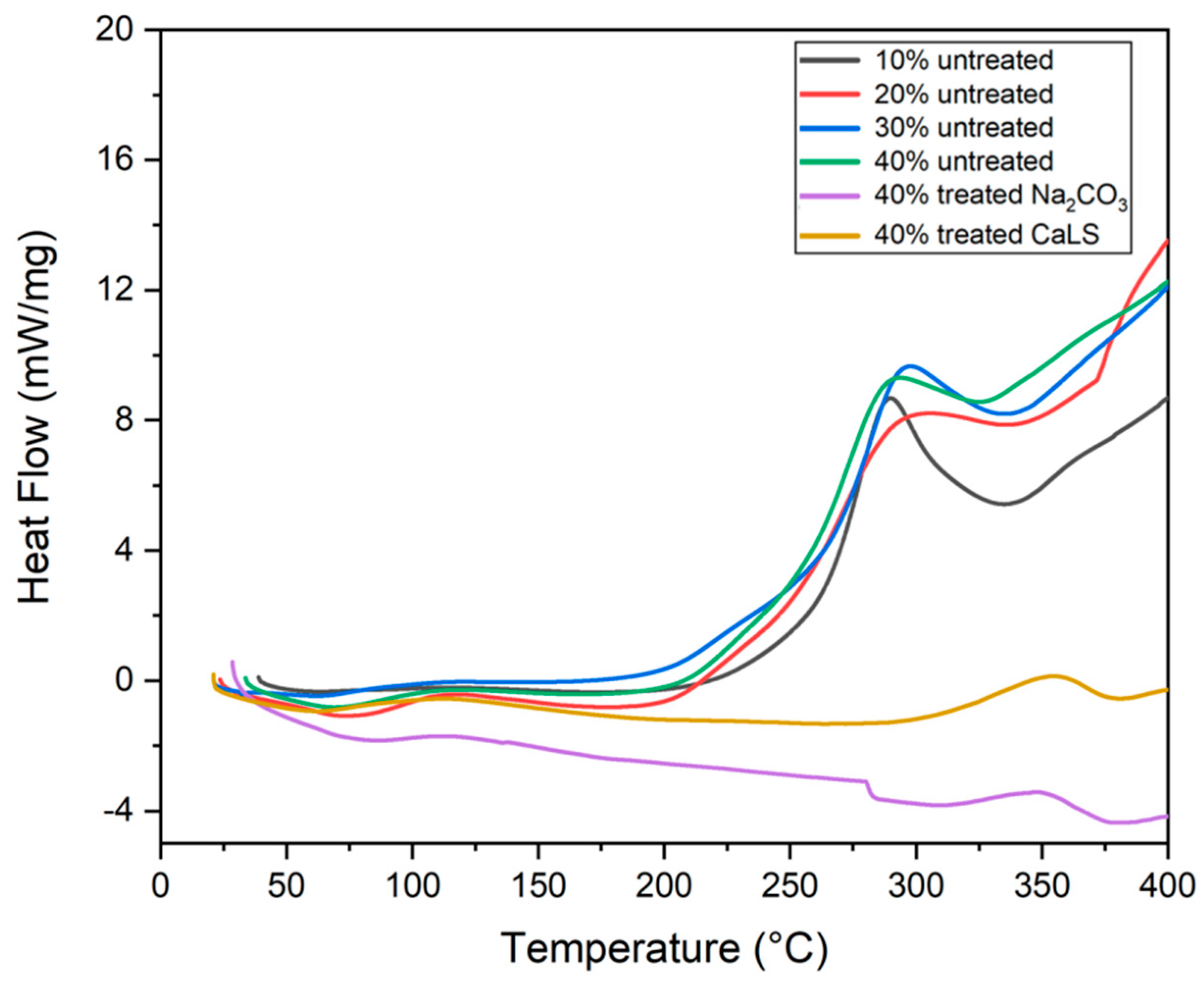
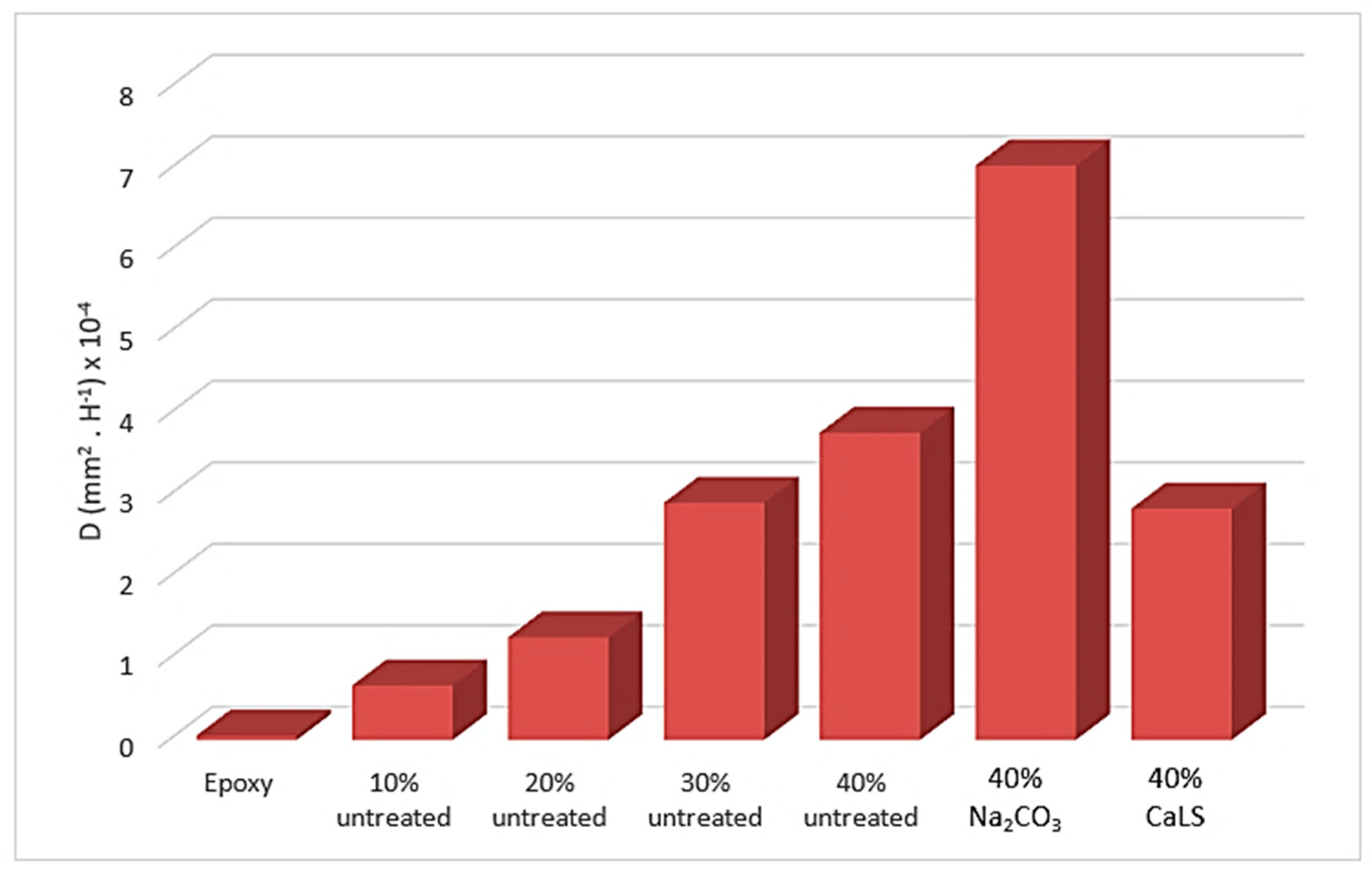


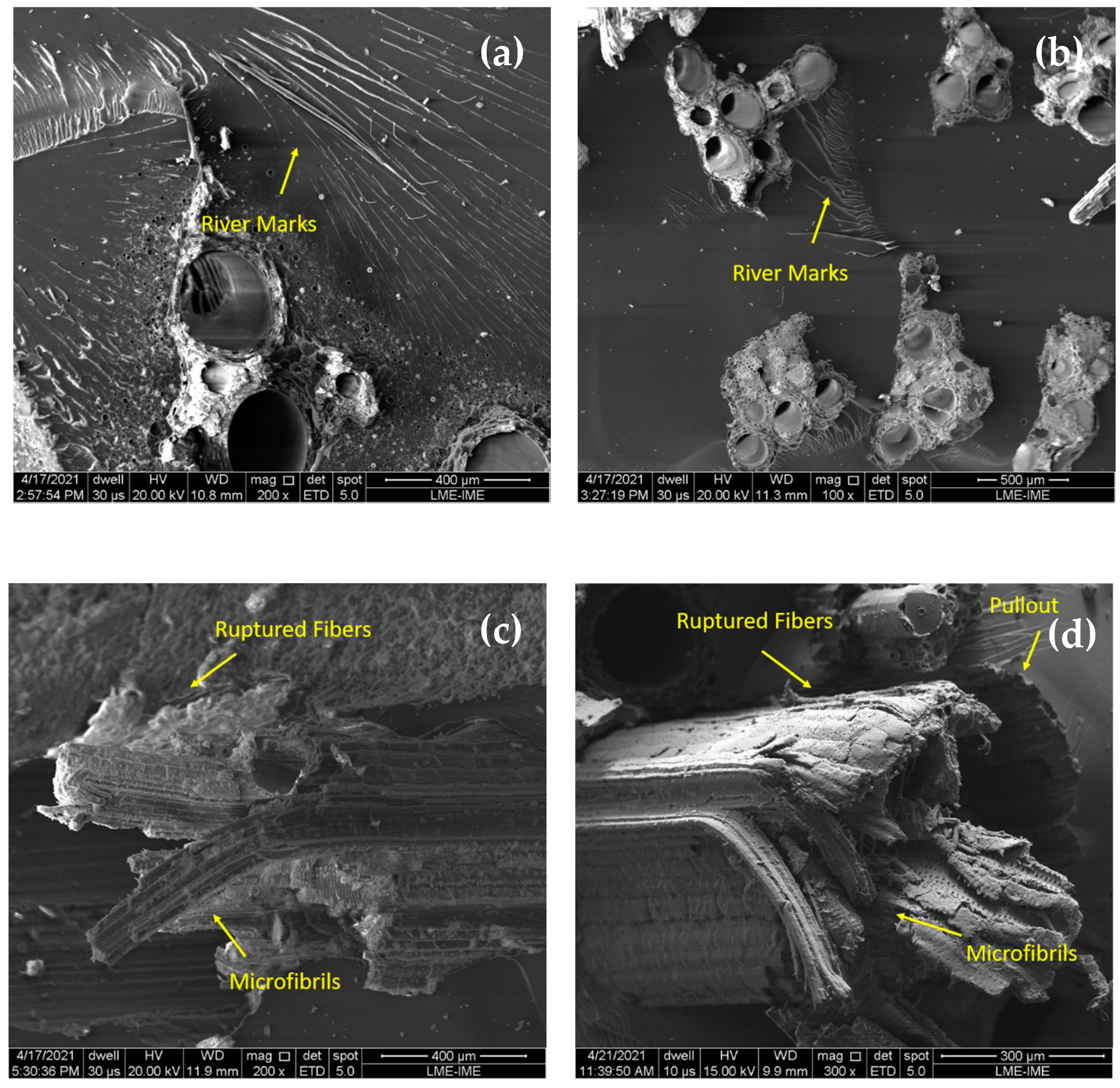

| Sample | Mass Loss up to 200 °C (%) | Initial Decomposition Temperature (°C) | Temperature of Maximum Decomposition Rate (°C) | Mass Loss at the End of Second Stage (%) | Mass Loss at 700 °C (%) |
|---|---|---|---|---|---|
| Epoxy | 1.99 | 311.5 | 356.4 | 67.38 | 81.41 |
| TVF untreated | 8.96 | 258.7 | 352.4 | 63.16 | 98.58 |
| TVF Na2CO3 | 10.32 | 249.8 | 318.5 | 54.11 | 91.79 |
| TVF CaLS | 9.73 | 257.0 | 360.1 | 56.24 | 87.78 |
| 10% untreated | 1.95 | 289.1 | 311.7 | 53.22 | 97.86 |
| 20% untreated | 2.57 | 294.5 | 337.1 | 54.24 | 87.97 |
| 30% untreated | 2.61 | 292.1 | 322.5 | 51.12 | 94.19 |
| 40% untreated | 2.83 | 296.3 | 342.4 | 60.41 | 84.65 |
| 40% Na2CO3 | 1.67 | 268.8 | 313.5 | 54.06 | 98.07 |
| 40% CaLS | 2.11 | 293.7 | 347.3 | 60.33 | 82.67 |
| Sample | D (mm2·h−1) × 10−4 | k |
|---|---|---|
| Epoxy | 0.054 | 0.996 |
| 10% untreated | 0.670 | 0.989 |
| 20% untreated | 1.260 | 0.984 |
| 30% untreated | 2.910 | 0.973 |
| 40% untreated | 3.770 | 0.975 |
| 40% treated Na2CO3 | 7.050 | 0.966 |
| 40% treated CaLS | 2.840 | 0.974 |
| Charpy | Izod | |||||||||
|---|---|---|---|---|---|---|---|---|---|---|
| Sample | β | θ | R2 | Eabsorbed (J/m) | Standard Deviation | β | θ | R2 | Eabsorbed (J/m) | Standard Deviation |
| Epoxy | 6.86 | 61.41 | 0.98 | 61.52 | 7.89 | 3.03 | 46.31 | 0.83 | 42.24 | 15.91 |
| 10% untreated | 6.7 | 69.25 | 0.94 | 66.44 | 8.72 | 2.23 | 23.29 | 0.96 | 24.20 | 6.10 |
| 20% untreated | 8.45 | 51.78 | 0.98 | 50.54 | 5.73 | 2.27 | 23.6 | 0.96 | 25.43 | 6.58 |
| 30% untreated | 10.23 | 62.24 | 0.98 | 62.13 | 5.22 | 10.27 | 42.67 | 0.82 | 41.01 | 4.37 |
| 40% untreated | 5.8 | 74.67 | 0.96 | 75.05 | 7.32 | 4.99 | 61.02 | 0.92 | 58.65 | 9.26 |
| 40% treated Na2CO3 | 7.2 | 71.19 | 0.93 | 68.28 | 8.08 | 4.34 | 67.07 | 0.79 | 61.11 | 15.20 |
| 40% treated CaLS | 3.4 | 88.5 | 0.94 | 80.59 | 24.53 | 4.27 | 59.52 | 0.91 | 53.31 | 13.89 |
Publisher’s Note: MDPI stays neutral with regard to jurisdictional claims in published maps and institutional affiliations. |
© 2021 by the authors. Licensee MDPI, Basel, Switzerland. This article is an open access article distributed under the terms and conditions of the Creative Commons Attribution (CC BY) license (https://creativecommons.org/licenses/by/4.0/).
Share and Cite
da Cunha, J.d.S.C.; Nascimento, L.F.C.; da Luz, F.S.; Monteiro, S.N.; Lemos, M.F.; da Silva, C.G.; Simonassi, N.T. Physical and Mechanical Characterization of Titica Vine (Heteropsis flexuosa) Incorporated Epoxy Matrix Composites. Polymers 2021, 13, 4079. https://doi.org/10.3390/polym13234079
da Cunha JdSC, Nascimento LFC, da Luz FS, Monteiro SN, Lemos MF, da Silva CG, Simonassi NT. Physical and Mechanical Characterization of Titica Vine (Heteropsis flexuosa) Incorporated Epoxy Matrix Composites. Polymers. 2021; 13(23):4079. https://doi.org/10.3390/polym13234079
Chicago/Turabian Styleda Cunha, Juliana dos Santos Carneiro, Lucio Fabio Cassiano Nascimento, Fernanda Santos da Luz, Sergio Neves Monteiro, Maurício Ferrapontoff Lemos, Cristina Gomes da Silva, and Noan Tonini Simonassi. 2021. "Physical and Mechanical Characterization of Titica Vine (Heteropsis flexuosa) Incorporated Epoxy Matrix Composites" Polymers 13, no. 23: 4079. https://doi.org/10.3390/polym13234079







